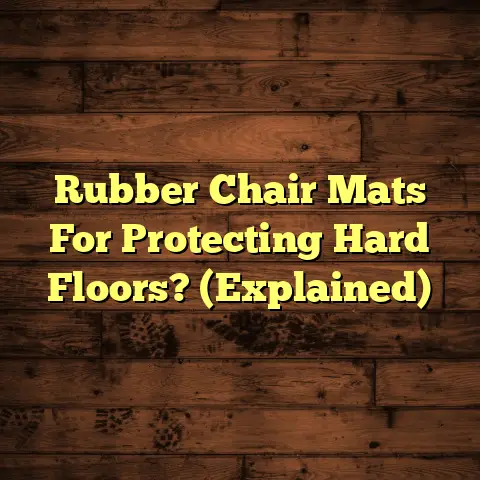How Do I Epoxy Garage Concrete Floor? (Explained)
Imagine walking into your garage, and instead of the usual dull, cracked concrete floor, you see a sleek, glossy surface that not only enhances the space but also holds up against spills and stains.
This was my vision when I decided to epoxy my garage concrete floor.
Over the years, I’ve learned a lot about the intricacies of this process, from preparation to application and maintenance.
In this extensive guide, I’ll share everything you need to know to successfully epoxy your garage floor, including personal experiences, challenges encountered, and invaluable tips.
Understanding Epoxy Flooring
Epoxy flooring is a popular choice for garages due to its durability and aesthetic appeal.
It consists of a mixture of resin and hardener that cures to form a tough, protective coating over concrete surfaces.
This layer not only enhances the appearance of the garage but also provides resistance against various elements, including moisture, chemicals, and stains.
Epoxy flooring is available in various styles and colors, allowing you to customize your garage according to your preferences.
The application process involves several steps, each crucial to achieving a successful finish.
The Benefits of Epoxy Flooring
Before diving into the specifics of application, let’s discuss why I chose epoxy flooring in the first place.
Here are some advantages that stood out to me:
- Durability: Epoxy floors can withstand heavy loads and resist impact damage, making them perfect for garages where vehicles are parked.
- Chemical Resistance: Spills from oil, gasoline, or other automotive fluids won’t damage an epoxy surface, which is a significant advantage over traditional concrete.
- Aesthetic Appeal: With a variety of colors and finishes available, epoxy floors can significantly enhance the look of your garage.
- Ease of Maintenance: Cleaning an epoxy floor is straightforward; a simple mop and mild detergent are usually all that’s needed.
- Cost-Effectiveness: While the initial investment may be higher than paint or other options, the longevity and durability of epoxy make it a cost-effective solution in the long run.
- Slip Resistance: Many epoxy systems come with anti-slip additives, improving safety in the garage.
Preparation: Setting the Stage for Success
The key to a successful epoxy floor installation lies in proper preparation.
I learned this after my first attempt at applying epoxy when I rushed through the prep work and faced several issues later on.
Here’s a comprehensive breakdown of the preparation process:
Cleaning the Concrete Floor
Cleaning the concrete surface is the first step in preparing for epoxy application.
Here’s how I tackled this important task:
- Remove All Items: I began by clearing everything out of the garage—tools, equipment, and vehicles—to have a clear workspace.
- Dust and Debris Removal: Using a broom and dustpan, I swept up loose dirt and debris.
This step is essential as any remaining dust can interfere with adhesion. - Pressure Washing: I rented a pressure washer to thoroughly clean the surface.
This method effectively removed embedded dirt and grime that regular cleaning couldn’t eliminate. - Degreasing: Since my garage is often used for automotive work, I applied a degreaser to tackle oil stains and allowed it to sit for 15-30 minutes before rinsing it off with water.
Inspecting and Repairing Cracks
After cleaning, I inspected the concrete for cracks and chips:
- Identifying Damage: I looked for any visible cracks or imperfections that needed addressing.
Even small cracks can lead to significant problems if not repaired before applying epoxy. - Filling Cracks: For any cracks larger than 1/8 inch, I used a concrete repair compound.
I followed the manufacturer’s instructions carefully and allowed it to cure for at least 24 hours before moving on.
Etching the Concrete Surface
Etching is an essential step that prepares the surface for better adhesion:
- Choosing an Etching Solution: I opted for muriatic acid because it’s effective at creating a rougher texture on smooth concrete surfaces.
Always wear protective gear when handling this chemical! - Application: I mixed the muriatic acid with water (following safety guidelines) and applied it using a garden sprayer.
After letting it sit briefly, I scrubbed the surface with a stiff brush before rinsing thoroughly with water.
Choosing the Right Epoxy
With preparation complete, I faced another challenge—choosing the right epoxy product.
It can be overwhelming given the variety available on the market:
Types of Epoxy
- 1-Part Epoxy: This type comes pre-mixed and is easier to apply but typically offers less durability compared to 2-part systems.
It’s suitable for light-duty applications but may not hold up well under heavy use. - 2-Part Epoxy: This system requires mixing a resin and hardener before application.
It provides superior durability and chemical resistance, making it ideal for garage flooring where heavy loads and spills are common.
Cost Considerations
During my research, I found that quality epoxy kits ranged from $100 to $300 for a standard two-car garage (approximately 400 square feet).
Using FloorTally was extremely helpful here; it allowed me to compare local suppliers’ prices effortlessly and select an option that fit my budget without sacrificing quality.
Application Process: Step-by-Step Guide
Once I settled on an epoxy product and had everything prepared, it was time for application.
This part is where the real transformation happens:
Mixing the Epoxy
Following manufacturer instructions carefully is crucial:
- Proper Ratios: For my selected 2-part epoxy system, I measured out equal parts of resin and hardener in a clean bucket.
- Mixing Technique: I stirred slowly to avoid incorporating air bubbles into the mixture, which could interfere with the final finish.
- Time Constraints: Once mixed, I had about 30 minutes before it began to set—timing was essential here.
Applying the Epoxy
The application process requires careful attention:
- Starting Point: I began in the farthest corner of the garage and worked my way toward the exit to avoid stepping on wet surfaces.
- Using Rollers: Using a roller attached to an extension pole made applying even coats easy.
I poured out small sections of epoxy and rolled it out evenly for coverage. - Working Methodically: To prevent laps or uneven areas, I worked in small sections—about 4 feet by 4 feet at a time—rolling out each section before moving on.
- Adding Decorative Flakes: After applying an initial coat, I sprinkled decorative flakes onto the wet surface for added texture and aesthetics.
This step was fun but required careful coordination to ensure even distribution.
Curing Time
After finishing application:
- Initial Setting: The epoxy began curing quickly; however, I resisted walking on it for at least 24 hours.
- Full Cure Time: For vehicles, I waited 72 hours before parking my car on the new floor.
Patience paid off here; rushing could lead to damage or imperfections.
Challenges Faced During Installation
While my project had many rewarding moments, it wasn’t without challenges:
- Temperature Variations: During my first application attempt in summer heat, I noticed bubbles forming due to rapid curing.
This taught me to always check temperature guidelines recommended by manufacturers. - Coverage Issues: On my second attempt, I miscalculated how much product I needed for full coverage.
Luckily, FloorTally helped me estimate quantities accurately by factoring in square footage and desired thickness.
Maintenance Tips for Longevity
After successfully installing my epoxy floor, I wanted to ensure its longevity through proper maintenance:
- Regular Cleaning Schedule: Establishing a routine cleaning schedule helped keep my garage looking pristine.
A quick sweep followed by mopping every few weeks kept dirt at bay. - Avoid Harsh Chemicals: While epoxy is resistant to many substances, using strong solvents or harsh cleaners could degrade its surface over time.
- Immediate Spill Cleanup: Addressing spills immediately minimized staining risks from oil or other automotive fluids.
- Periodic Inspections: Every few months, I inspected the floor for signs of wear or damage—addressing issues promptly helped maintain its integrity.
Comparative Analysis with Other Flooring Options
After successfully installing an epoxy floor in my garage, I took some time to compare it with other flooring options I’d considered:
- Vinyl Flooring: While vinyl can offer attractive aesthetics at a lower price point than epoxy, it lacks durability under heavy loads and can be damaged by sharp objects or chemicals.
- Painted Concrete Floors: Concrete paint may seem like an easy solution; however, it often chips or peels over time due to wear and insufficient adhesion compared to epoxy coatings.
- Polished Concrete: Polishing adds shine but doesn’t provide protection against spills or stains like epoxy does—epoxy offers both aesthetic appeal and functional benefits.
Conclusion
Epoxying your garage floor is not just about enhancing aesthetics; it’s also about creating a durable surface that can withstand the rigors of daily use.
From my initial preparations through successful application and ongoing maintenance, I’ve learned that patience and attention to detail are key factors in this process.
If you’re considering upgrading your garage flooring, take your time planning each step carefully—from preparation through installation—and you’ll reap the rewards in both functionality and appearance for years to come.
Through my experiences—both successes and challenges—I hope this guide serves as a valuable resource as you embark on your own epoxying journey.





